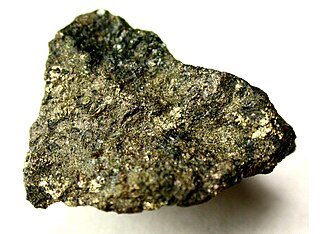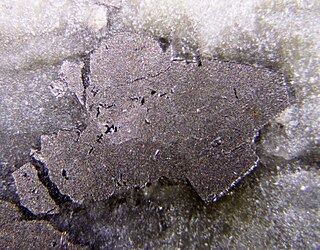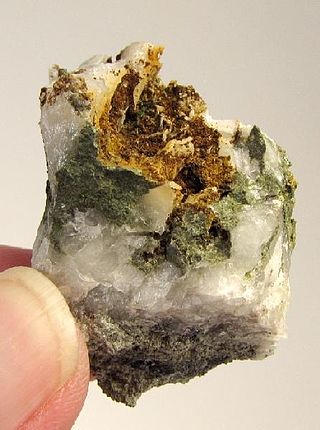Related Research Articles

Pentlandite is an iron–nickel sulfide with the chemical formula (Fe,Ni)9S8. Pentlandite has a narrow variation range in nickel to iron ratios (Ni:Fe), but it is usually described as 1:1. In some cases, this ratio is skewed by the presence of pyrrhotite inclusions. It also contains minor cobalt, usually at low levels as a fraction of weight.

Germanite is a rare copper iron germanium sulfide mineral, Cu26Fe4Ge4S32. It was first discovered in 1922, and named for its germanium content. It is only a minor source of this important semiconductor element, which is mainly derived from the processing of the zinc sulfide mineral sphalerite. Germanite contains gallium, zinc, molybdenum, arsenic, and vanadium as impurities.

Bornite, also known as peacock ore, is a sulfide mineral with chemical composition Cu5FeS4 that crystallizes in the orthorhombic system (pseudo-cubic).

Pyrrhotite is an iron sulfide mineral with the formula Fe(1-x)S. It is a nonstoichiometric variant of FeS, the mineral known as troilite. Pyrrhotite is also called magnetic pyrite, because the color is similar to pyrite and it is weakly magnetic. The magnetism decreases as the iron content decreases, and troilite is non-magnetic. Pyrrhotite is generally tabular and brassy/bronze in color with a metallic luster. The mineral occurs with mafic igneous rocks like norites, and may form from pyrite during metamorphic processes. Pyrrhotite is associated and mined with other sulfide minerals like pentlandite, pyrite, chalcopyrite, and magnetite, and has been found globally.

Cobaltite is a sulfide mineral composed of cobalt, arsenic, and sulfur, CoAsS. It naturally appears in the form of a tetartoid, a form of dodecahedron with chiral tetrahedral symmetry. Its impurities may contain up to 10% iron and variable amounts of nickel. Structurally, it resembles pyrite (FeS2) with one of the sulfur atoms replaced by an arsenic atom.

Bournonite is a sulfosalt mineral species, trithioantimoniate of lead and copper with the formula PbCuSbS3.

Clausthalite is a lead selenide mineral, PbSe. It forms a solid solution series with galena PbS.

Digenite is a copper sulfide mineral with formula: Cu9S5. Digenite is a black to dark blue opaque mineral that crystallizes with a trigonal–hexagonal scalenohedral structure. In habit it is usually massive, but does often show pseudo-cubic forms. It has poor to indistinct cleavage and a brittle fracture. It has a Mohs hardness of 2.5 to 3 and a specific gravity of 5.6. It is found in copper sulfide deposits of both primary and supergene occurrences. It is typically associated with and often intergrown with chalcocite, covellite, djurleite, bornite, chalcopyrite and pyrite. The type locality is Sangerhausen, Thuringia, Germany, in copper slate deposits.

Carrollite, CuCo2S4, is a sulfide of copper and cobalt, often with substantial substitution of nickel for the metal ions, and a member of the linnaeite group. It is named after the type locality in Carroll County, Maryland, US, at the Patapsco mine, Sykesville.

Temagamite is a bright white palladium mercury telluride mineral with a hardness of 2+1⁄2 on the Mohs scale. Its chemical formula is Pd3HgTe3. It was discovered at the Temagami Mine on Temagami Island, Lake Temagami in 1973, and it represents a rare mineral in the Temagami Greenstone Belt.
Anandite is a rare phyllosilicate with formula (Ba,K)(Fe2+,Mg)3(Si,Al,Fe)4O10(S,OH)2. It crystallizes in the monoclinic crystal system. It is black in color with a glassy luster and a near perfect cleavage.

Athabascaite is a member of the copper selenide minerals, and forms with other copper selenides. It was first discovered by S. Kaiman in 1949 while he was researching radioactive materials around Lake Athabasca. Kaiman was conducting research near Uranium City, Saskatchewan where mass amounts of uranium mines were present.
Jolliffeite is a rare selenide mineral with formula NiAsSe or (Ni,Co)AsSe. It is the selenium analogue of the sulfide mineral gersdorffite, NiAsS, with a common impurity of cobalt, CoAsSe. It is named for its discoverer, Alfred Jolliffe, (1907–1988), a Canadian geologist of Queen's University, Kingston, Ontario.

Chanabayaite is the first recognized triazolate mineral, having the formula Cu
2(N
3C
2H
2Cl
4.

Kruťaite, simplified Krut'aite or krutaite, is a rare mineral with the formula CuSe2. It crystallises in the cubic crystal system. It is part of the pyrite group, being composed of Cu2+ ions and Se22− ions. The mineral is most often found as a dark grey aggregate consisting of tiny crystals no more than a millimeter in size. The crystals are opaque in any size. It has no industrial use, but it is a prized collector's item.

Teineite is a tellurite mineral with the formula Cu(TeO3). 2 H2O. It has a Mohs hardness of 2.5 and it comes in many different shades of blue, ranging from cerulean blue to bluish-gray. The mineral millsite has the same chemical composition, but crystallizes in the monoclinic system, while teineite crystallizes in the orthorhombic system.

Trogtalite is a rare selenide mineral with the formula CoSe2. It crystallizes in the cubic system and is part of the pyrite group, consisting of Co2+ and Se22− ions. It has a rose-violet colour and its crystals are opaque. It often occurs as grains. It was thought to be dimorphous with hastite, but this was discredited in 2009. Hastite turned out to be the iron selenide mineral ferroselite. It forms a solid solution series with kruťaite.

Berzelianite is a rare copper selenide mineral with the formula Cu2Se. It occurs as thin dendritic crusts or as fine-grained inclusions. It crystallizes in the isometric system, unlike its dimorph, bellidoite, which crystallizes in the tetragonal system. The crystals are opaque and slightly malleable.

Khinite is a rare tellurate mineral with the formula Pb2+Cu2+3TeO6(OH)2. It crystallizes in the orthorhombic system and has a bottle-green colour. It is often found as dipyramidal, curved or corroded crystals no more than 0.15 mm in size. The tetragonal dimorph of khinite is called parakhinite.

Oosterboschite is a rare selenide mineral with the formula (Pd,Cu)7Se5. It crystallises in the orthorhombic crystal system. It has a creamy yellow colour and a Moh's hardness of 5. It is often found as grains with no clear shape. The crystals are opaque and often no bigger than 0.4 mm.
References
- ↑ Warr, L.N. (2021). "IMA–CNMNC approved mineral symbols". Mineralogical Magazine. 85 (3): 291–320. Bibcode:2021MinM...85..291W. doi: 10.1180/mgm.2021.43 . S2CID 235729616.
- ↑ "Eskebornite: Eskebornite mineral information and data". www.mindat.org. Retrieved 2016-10-24.
- ↑ Barthelmy, Dave. "Eskebornite Mineral Data". webmineral.com. Retrieved 2016-10-24.
- 1 2 "Handbook of Mineralogy, Eskebornite" (PDF).
- ↑ "Chalcopyrite-Eskebornite Series: Chalcopyrite-Eskebornite Series mineral information and data". www.mindat.org. Retrieved 2016-10-24.
- ↑ D.C. Harris, E.A.J. Burke. "Eskebornite, two Canadian occurrences" (PDF). The Canadian Mineralogist. 10: 786–796.